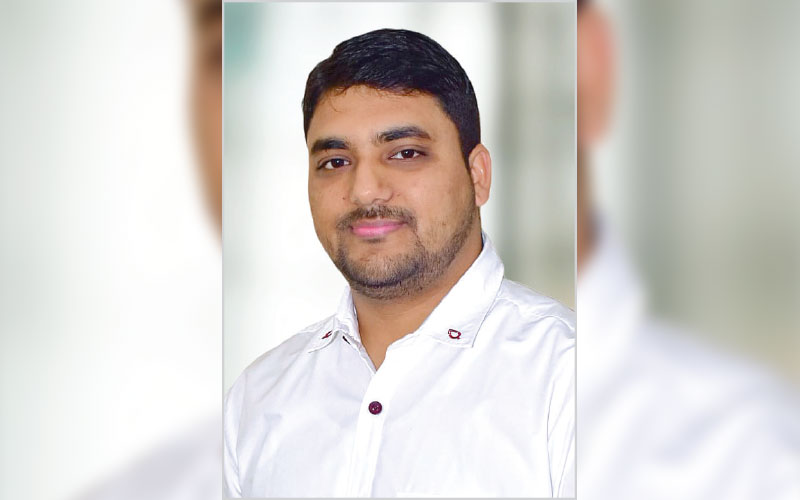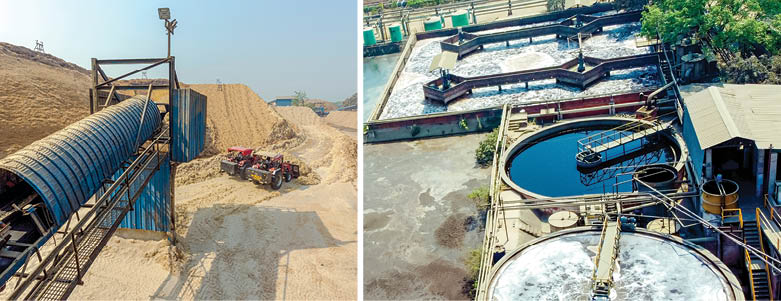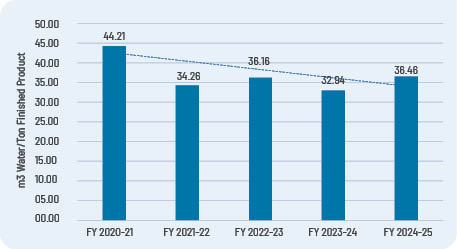Pakka Limited has achieved an average water consumption of approximately 36 m³ per ton of finished product, well below the statutory guideline of 50 m³/ton. The company has reduced freshwater usage in its paper machines by over 90% and is currently reusing about 50% of the total treated water within its process operations. In an exclusive interview with Paper Mart, Mr. Shashi Verma, Environment Head, Pakka Limited-Ayodhya, reveals that the company is firmly committed to lowering its average water consumption to below 22 m³ per ton of finished product by 2030. Looking ahead, Pakka also plans to shift from reactive response to intelligent, data-driven operations for managing water and other resources over the next decade.

Paper Mart: How has your understanding or approach to water circularity evolved over time? How close are you to achieving it?
Shashi Verma: Water circularity, particularly for the pulp and paper sector, has always been an integral part of it. Starting from the 19th century, when the freshwater requirement was around 300-500 m3 per ton of paper (m3/ton) produced, then by the early 20th century it came down to 100-300 m3/ton produced and then by the early 21st century, the pulp and paper sector achieved below 100 m3/ton specific water consumption and today (2020-2025), most of the mills brought it down below 50 m3/ton of finished product with exception to some of the global cutting-edge mills operating much below 25 m3/ton of paper produced.
So, the concept of water circularity is not new for the pulp and paper sector, and it has always challenged the norm. In the past 3 years, Pakka has achieved an average water consumption of around 36 m3/ton of finished product, where the statutory guidelines were to achieve below 50 m3/ton of finished product. Despite tailoring specialised disposable paper packaging products catering to some of the critical applications globally, in the past 7 years, Pakka has remarkably brought down the freshwater consumption, and we are further committed to achieving below 30 m3/ton by the end of 2026, 25 m3/ton by the end of 2027 and below 22 m3/ton of finished product by 2030.
Watch: In Pursuit of Lesser Water Footprint
PM: To what extent have you implemented internal water reuse, recovery, or circular systems (including ZLD, water loop closure, or rainwater harvesting)?
SV: At Pakka, in the last 5 years, we have been very aggressively focused on internal water reuse or circular systems. For this, we have installed Micro Plate Settlers (MPS), Dissolved Air Flotation (DAF), which are being used at paper machines, moulded product section and wet lap pulp machine. Even at the wet washing section of the pulp mill, MPS are playing a pivotal role in achieving a circular system for the washing of the raw material.
In our paper machines, we have reduced freshwater consumption by more than 90% by reusing the machine backwater as clarified water back into the paper machine process, MP/LP showers.
In the sludge dewatering system at the belt press area, we replaced the use of fresh or even treated water at the belt press showers by reusing the belt press filtrate water after clarifying it and sending back the settled TSS to the belt press, further reducing the circular solid load at the effluent treatment plant.
Other than equipment-based water conservation, Pakka has implemented many innovative strategies based on cross-functional brainstorming sessions, be it reusing the RO reject water stream, or reusing the cooling tower blowdown purge back into the pulp mill section.
Apart from that, we ensure water reuse & waste reduction. We are also reusing around 50% of the total treated water back into the process activities – bagasse water sprinkling, wet washing, pulp mill washers & other operational activities within the plant premises, further significantly reducing the freshwater dependency. Some of the sections are operating with 100% ETP-treated water, and our paper machines are saving more than 90% of the freshwater by reutilising their backwater.

Full circularity is the blueprint which we chose at Pakka. Rather than giving the limits on mg/litre (or PPM), it would be much better to check pollutants on kg/ton of product or kg/day basis, giving much relaxation to the mills while making significant internal efforts and a push towards water circularity.
PM: Which technologies or solutions have you found most effective in reducing your freshwater consumption or increasing internal recycling?
SV: There could be nothing more effective than avoiding a problem before it arises. As stated in the previous point, managing backwater at source and then reusing it is always the best strategy. There is high compatibility of the backwater at its sources, where it can be reused before mixing it with other wastewater streams, which makes it challenging to reuse it in a specific activity because of the added impurities from other sections.

PM: What are the biggest roadblocks (technical, financial, or regulatory) in achieving higher levels of water reuse or moving toward ZLD?
SV: Let’s first discuss the technical aspects. While reusing the water, majorly, we can do treatment in two ways – chemi-physical (solid separation) and biological (removing organic impurities). While doing so, the inorganic part keeps building up within the water streams as TDS, making its reusability and treatability difficult with each cycle of reuse.
Now, there is a solution, I don’t believe it’s a treatment, but it is a separation or filtration technique. We filter out the inorganic part from the water using membranes, and the technology is widely known as Reverse Osmosis (RO).
There are broadly two major challenges of using RO for the wastewater – first is the COD present in the wastewater; the higher the COD levels, the more complex it is to make RO membranes functional due to biofouling and the second is handling the high concentrate RO reject stream (contains dissolved solids – majorly inorganic salts), which we recover while filtering out the water through the membranes.

There is always a solution to the problem, but here comes the financial aspect. While dealing with the wastewater COD before feeding it to the RO system or handling the highly concentrated RO reject to recover the inorganic salts, for an industry like pulp and paper, which runs on a very thin profit margin, is a key economic challenge to deal with. ZLD comes with a staggering cost for water intensive industries like pulp and paper industry, keeping aside technical challenges involved in dealing with COD before the RO feed and dealing with other parameters, like silica, as well.
Talking about the regulatory aspects, Indian environmental regulations are stringent & getting stricter with each passing year. Regulatory bodies have imposed a limit on the TDS, which is contradictory to the push towards achieving ZLD, especially for integrated pulp and paper mills.
Statutory norms are made in general for all the mills irrespective of their efforts towards water conservation, investments made to promote a circular system, etc. Apart from this, the limits set for key parameters like COD, BOD, TSS, etc., come with no exception, restricting companies to try for significant water reuse – the more water reuse more will be the parameter concentrations. Rather than giving the limits on mg/litre (or PPM), it would be much better to check pollutants on kg/ton of product or kg/day basis, giving much relaxation to the mills which have conserved significant water with their internal efforts and have made a push towards water circularity.
PM: How do local or national regulations affect your water management goals? Have sustainability mandates accelerated your water-saving initiatives?
SV: At Pakka, our primary goal is to protect Mother Earth. Irrespective of the local/national guidelines, we always remained focused on water reuse initiatives and water treatment technologies to reduce our environmental footprint.
Rather than mandates, volunteer disclosure guidelines, BRSR, ESG, etc, have motivated the companies to go beyond the set standards to stand apart from the rest. Your journey is a story which your employees, customers, partners and investors are interested in, and this story should motivate way better than the mandates and regulations push.
Also Read: Chandpur Paper Committed to Water Circularity, Aligns With Regulatory Requirement
PM: Have your investments in water reuse or ZLD technologies paid off in terms of savings, efficiency, or compliance?
SV: In the last 5 years, Pakka has brought down the specific water consumption from around 45 m3/ton of the products to ~36 m3/ton of the products. This significantly reduced the potential use of the freshwater in operations. CII recognised Pakka Limited as “Noteworthy Water Efficient Unit” during the National Award for Excellence in Water Management during the years 2022 and 2023, consecutively.
PM: Do you involve technology providers in planning or customising your water treatment systems? Any successful collaborations worth sharing?
SV: We have internal teams with specified water consumption targets for each section to keep an eye on, so that the given targets are achieved for each section. There are daily reviews of the targets and periodic meetings to discuss the innovative and customized approach for water savings. Further, technology suppliers are involved on a case-by-case basis. We also participate in national/international level events to keep the teams updated on the recent development of water conservation techniques.

CII recognised Pakka Limited as “Noteworthy Water Efficient Unit” during the National Award for Excellence in Water Management during the years 2022 and 2023, consecutively.
PM: How do you see your water use evolving in the next 5–10 years? What would “full circularity” look like in your operations? What kinds of support in terms of technology, partnerships, or policies would help you get there?
SV: For us at Pakka, the picture is very clear: in the next decade, we will see a shift from reactive to intelligent, data-driven operations, be it water or any resource. The human brain is going to be focused on efficiency and avoiding repetitive tasks. Smart use of data integrated with AI will solve complex challenges, doing RCA, problem solving & performing predictive analytics and making decisions well before the event happens.
Full circularity is the blueprint which we chose to walk through at Pakka. We are a firm believer that whatever is produced utilising natural resources should be returned to nature without harming it or no damage to the environment; rather, it should add value to nature at the end of its life so that our next generations can get a cleaner planet.
In the global industrial umbrella, the pulp and paper is one of the sectors where we still have plenty of opportunities to innovate, and customize technology solutions. The speed of change and development we see in the automobile, pharma, and IT, that even after every 6 months we get a new version of the smartphone or laptop superior to ever before, the pulp and paper sector is far behind in that pace. The reasons could be many, maybe thin profit margins, fluctuating global dynamics between paper v/s plastic, lack of focused global R&D. A major shift is yet to happen, and I hope the next 10 years will be a boom for the pulp and paper sector, having a sector focused globally on funded R&D facilities to change the way the pulp and paper sector operates to meet the pace of technological advancement. Remember, paper is the most sustainable product ever discovered, irrespective of what we understand or know about paper.
PM: Have you considered or implemented digital twins to simulate, monitor, or optimise your water use? What kind of improvements could such systems bring to your operations?

SV: We are in transition towards technology innovation and digital twinning. Gradually, we are moving towards real-time decision-making dashboards. So far, we can fetch the real-time operation as well as financial contribution data to the real-time dashboards installed on shop floors for real-time data display, avoiding the hassle of going to a webpage to see the data.
Dedicated teams are continuously working on it to make it more and more reliable with each passing day. We are also in touch with technology partners offering IIoT, AI integration to this dashboard, so that decision-making could be quicker and automated. We have already entered an era where most of the tasks are being taken care of by AI without any human interference, with equivalent accuracy and at lightning speed. The next decade is going to be a historic transformation in automation and decision-making. We at Pakka are open and curious to rewrite the next generation of automation in an industrial setup.
PM: What is your current annual water consumption, and how has the consumption reduced over the past few years? Kindly support the answer with the table below.
SV: Our efforts are continuous, and apart from the steps taken to conserve water, one of the most challenging parts is to maintain what is already benchmarked. This needs time, training and a mindset to adopt the new normal. Sometimes we achieve, sometimes we fail, but in the long run, we improve, and we make a new benchmark, a new normal.
By the end of 2027, Pakka has targeted to achieve freshwater consumption below 25 m3/ton of finished product, and by the end of 2026, we are committed to bringing it down to 30 m3/ton of finished product.



